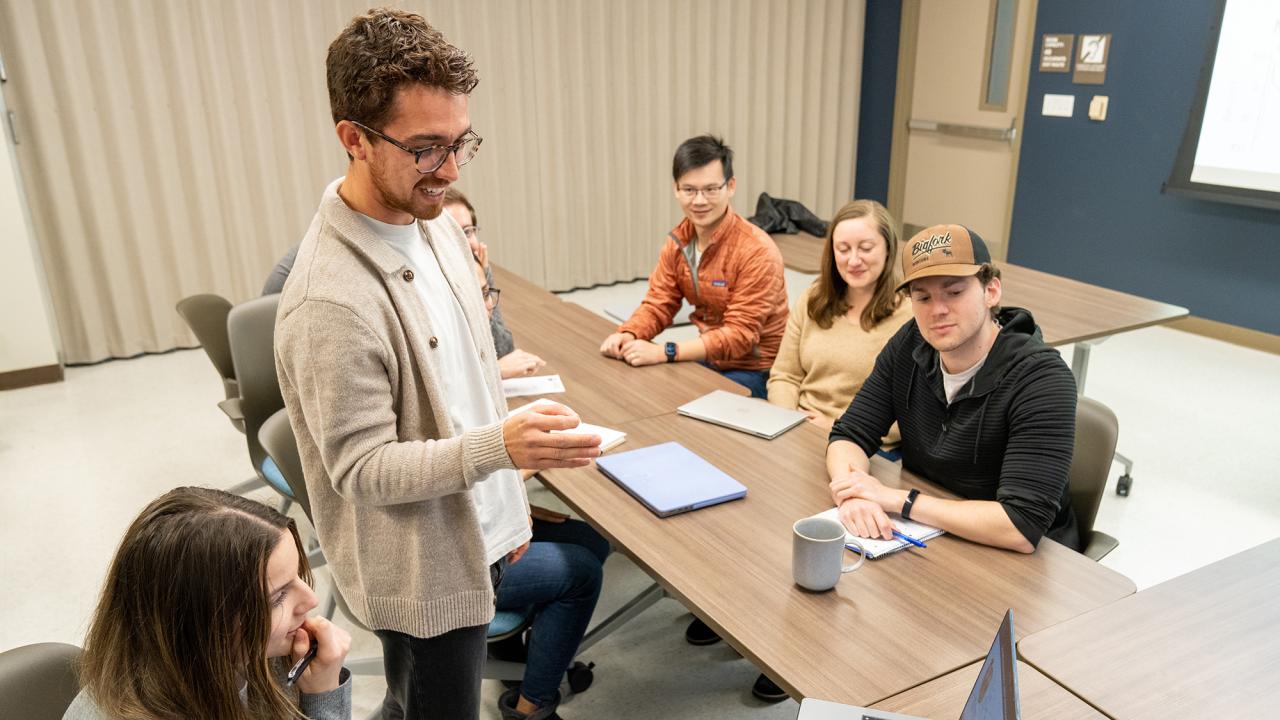
From Researcher to Educator: One Grad Student’s Path to Teaching
Nate Herrera’s UC Davis experience sparks a passion for STEM education
Graduate student Nathaniel (Nate) Herrera has used his last year at UC Davis to springboard a career in STEM teaching. Herrera, who joined UC Davis in 2021, studies sex differences in cardiac physiology within the Molecular, Cellular and Integrative Physiology Graduate Group. He’s been devoted to student mentorship and DEI since his time as an undergraduate and plans to embark on a career in teaching, hoping to spread his passion for STEM—and physiology in particular—with the next generation of undergraduates.
“Watching Nate’s journey has been inspiring,” said Eleonora Grandi, Herrera’s advisor and a professor in the School of Medicine’s Department of Pharmacology. “His dedication to mentorship and commitment to fostering an inclusive learning environment reflect his genuine passion for teaching and community engagement. Nate's efforts to support others on their academic journeys highlight his natural ability to lead and uplift those around him.”

Teaching’s tangible rewards
Herrera first realized he enjoyed teaching as an undergraduate at Washington State University, when he worked as a STEM tutor at the campus’s multicultural student center.
“I felt like I was actually having a tangible outcome on students’ performance,” said Herrera. “I'd never seen students that excited before. They were going from Ds to Cs, but they were so happy for just that minor progression, and the confidence that improvement gave them was enough to keep them going. They started progressing, and it felt like they needed me less and that they were learning how to learn, which was really nice.”
At UC Davis, Herrera continued to pursue his interest in mentorship by volunteering for STEM Squad, an after-school science program for middle school students. The group, which is student-run, goes into local schools on a weekly basis where they use hands-on activities to teach core concepts in STEM and to show the middle schoolers what it’s like to work in science.
Herrera also works on the Wellness, Inclusion, and Social Equity committee for the Molecular, Cellular, and Integrative Physiology and Biophysics graduate groups, and is a 2024-25 Graduate Advisor to the Dean, where he is focusing on advancing DEI initiatives.
Investigating sex differences in cardiac physiology
For his Ph.D. thesis, Herrera is using computational modeling to investigate sex differences in atrial fibrillation, the most common cardiac arrythmia. One in four people develop atrial arrythmia, but men tend to develop the disease earlier in life, whereas women have a later onset but are more likely to experience severe symptoms and issues with treatment.
“We have assumed for a long time that men and women's hearts are the same, but recent research has shown us that they don't function the same way,” said Herrera. “My work involves developing models of both the male and female atria which we can use to study sex-specific differences at the cellular level between healthy and diseased hearts.”
In recognition of his research and leadership qualities, Herrera received both the Irving I. Hertzendorf Memorial Award in Physiology and the Barbara Horwitz & John Horowitz Molecular, Cellular and Integrative Physiology Award in 2024.

Pivoting to a teaching career
Herrera spent his first few years at UC Davis diving into physiology research, but as he neared the end of his Ph.D. program, he realized he was more interested in teaching than in research. To this end, he enrolled in the Future Undergraduate Science Educators (FUSE) program, which prepares graduate students for a career in teaching by helping them develop teaching resources and a portfolio and by teaching them to teach.
“FUSE allows you to design where you want to teach in the future,” said Herrera. “A lot of the work that I've been doing in the program has revolved around teaching undergraduate physiology with an emphasis in DEI—so, linking my experience as the graduate advisor to the dean with my previous mentorship work, and teaching physiology because it's what I like.”
As part of the program, Herrera is preparing to independently teach a bioethics course this winter quarter.
“It's relatively rare for a graduate student to serve as the only instructor of record,” said Herrera. “This is a very independent and hands-on position, so I’m both scared and excited.”
He also co-taught a course called Navigating Graduate School this fall quarter alongside his adviser, Grandi.
“I took the course when I was a new graduate student four years ago,” said Herrera. “It helped me a lot and showed me resources that I still use today, so it's really gratifying to be able to provide those to students now and to help make the transition to graduate school easier and more seamless.”
Ultimately, Herrera hopes to teach within the University of California system, and he’s currently applying for postdoctoral positions in science education. For his postdoctoral studies, Herrera plans to study sex differences in biology education research, linking together his interests in teaching, physiology, and DEI.
“I don't want to leave the UC system. I really like its progressiveness and support systems, especially at Davis,” said Herrera. “My experiences here have been really good—there's been a lot of help and accommodations that have helped my trajectory.”
Media Resources
- Liana Wait is a freelance science writer based in Philadelphia. She has a Ph.D. in ecology and evolutionary biology and specializes in writing about the life sciences.
